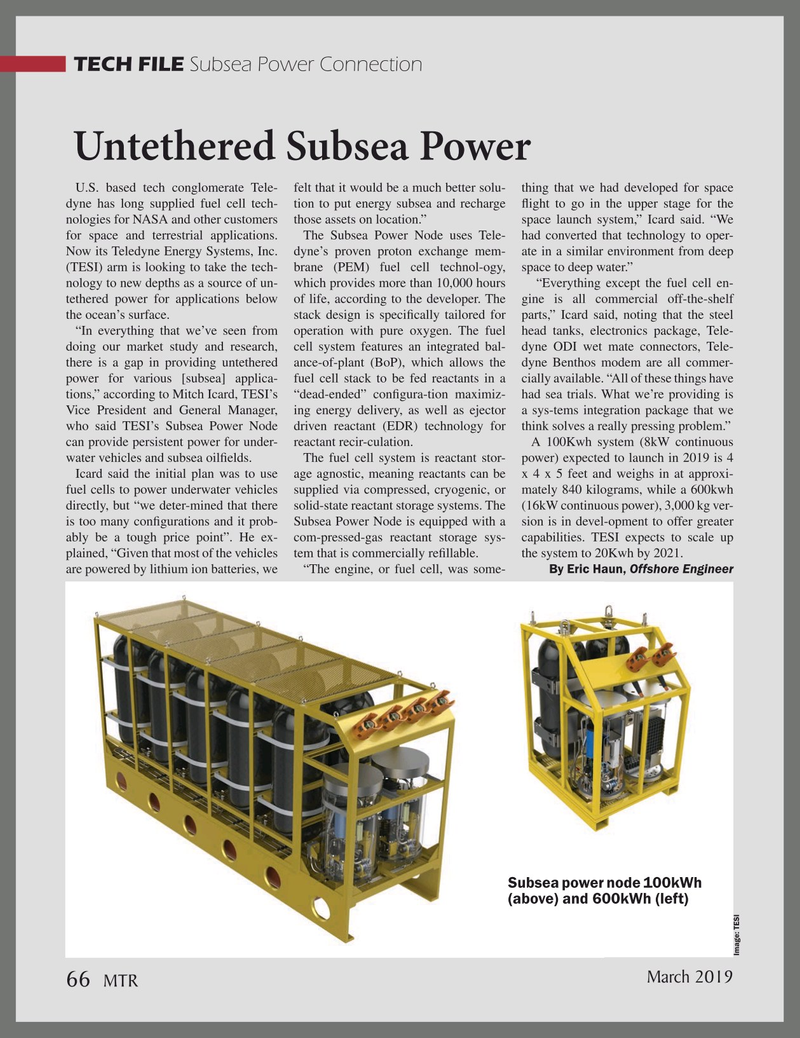
Page 66: of Marine Technology Magazine (March 2019)
Oceanographic Instrumentation: Measurement, Process & Analysis
Read this page in Pdf, Flash or Html5 edition of March 2019 Marine Technology Magazine
TECH FILE Subsea Power Connection
Untethered Subsea Power
U.S. based tech conglomerate Tele- felt that it would be a much better solu- thing that we had developed for space dyne has long supplied fuel cell tech- tion to put energy subsea and recharge ? ight to go in the upper stage for the nologies for NASA and other customers those assets on location.” space launch system,” Icard said. “We for space and terrestrial applications. The Subsea Power Node uses Tele- had converted that technology to oper-
Now its Teledyne Energy Systems, Inc. dyne’s proven proton exchange mem- ate in a similar environment from deep (TESI) arm is looking to take the tech- brane (PEM) fuel cell technol-ogy, space to deep water.” nology to new depths as a source of un- which provides more than 10,000 hours “Everything except the fuel cell en- tethered power for applications below of life, according to the developer. The gine is all commercial off-the-shelf the ocean’s surface. stack design is speci? cally tailored for parts,” Icard said, noting that the steel “In everything that we’ve seen from operation with pure oxygen. The fuel head tanks, electronics package, Tele- doing our market study and research, cell system features an integrated bal- dyne ODI wet mate connectors, Tele- there is a gap in providing untethered ance-of-plant (BoP), which allows the dyne Benthos modem are all commer- power for various [subsea] applica- fuel cell stack to be fed reactants in a cially available. “All of these things have tions,” according to Mitch Icard, TESI’s “dead-ended” con? gura-tion maximiz- had sea trials. What we’re providing is
Vice President and General Manager, ing energy delivery, as well as ejector a sys-tems integration package that we who said TESI’s Subsea Power Node driven reactant (EDR) technology for think solves a really pressing problem.” can provide persistent power for under- reactant recir-culation. A 100Kwh system (8kW continuous water vehicles and subsea oil? elds. The fuel cell system is reactant stor- power) expected to launch in 2019 is 4
Icard said the initial plan was to use age agnostic, meaning reactants can be x 4 x 5 feet and weighs in at approxi- fuel cells to power underwater vehicles supplied via compressed, cryogenic, or mately 840 kilograms, while a 600kwh directly, but “we deter-mined that there solid-state reactant storage systems. The (16kW continuous power), 3,000 kg ver- is too many con? gurations and it prob- Subsea Power Node is equipped with a sion is in devel-opment to offer greater ably be a tough price point”. He ex- com-pressed-gas reactant storage sys- capabilities. TESI expects to scale up plained, “Given that most of the vehicles tem that is commercially re? llable. the system to 20Kwh by 2021.
are powered by lithium ion batteries, we “The engine, or fuel cell, was some- By Eric Haun, Offshore Engineer
Subsea power node 100kWh (above) and 600kWh (left)
Image: TESI
March 2019 66
MTR
MTR #2 (66-79).indd 66 3/11/2019 4:40:56 PM

 65
65

 67
67
